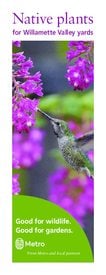Native plants are a great choice for hedgerows, gardens, streamside plantings, meadows, woodlands, and more because they provide food and shelter for wildlife and pollinators and are well-adapted to local moisture regimes and soil types. Willamette Valley native plants can tolerate cool wet winters and warm dry summers. They do not require added fertilizers, and rarely need supplemental water after a year or two of summer watering to help them get established. We promote the use of native plants with our native plant sale and other handy resources.
Native Plant Database

Search for native plants in our easy-to-use, image-rich database, filter by habitat type, growth form, and other characteristics.
Helpful Handouts

Native Willamette Valley Low Water Use Plants
This 2-sided handout lists trees, shrubs and flowering native plants, their light needs, soil moisture preferences, special uses, mature heights and descriptions.

Blooming Time Table of Native Plants
This 2-sided handout lists the boom time range and colors for a selection of Willamette Valley native plants.
Videos
Recommended Native Plant Resources

OregonFlora
OregonFlora has assembled a comprehensive guide to the ~4,700 vascular plants of Oregon that is shared through their website, the Flora of Oregon books, and their wildflower identification app.

Native Plants for Willamette Valley Yards
The native plants for Willamette Valley yards booklet includes 140 plants primarily native to the Portland metropolitan area. The native plants booklet was created by Metro in collaboration with more than 20 partners around the region.

The Meadowscaping Handbook
The Meadowscaping Handbook: Designing, Planting and Managing an Urban Meadow is a compilation of knowledge and “lessons learned” designed as a “how-to” publication to help gardeners, landscape professionals, and ecologists in the Willamette Valley plan, design, plant, and maintain native plant meadows on small urban plots.
Pollinator Plants: Maritime Northwest Region
This fact sheet produced by Xerces Society features regionally native plants that are highly attractive to pollinators and are well-suited for small-scale plantings in gardens, urban greenspaces, and farm field borders, and on business and school campuses.

Audubon Native Plants Database
Audubon Society has created a native plant database in support of birds. Enter your 5-digit zip code to use Audubon’s native plants database and explore the best plants for birds in your area, as well as local resources and links to more information.

Seek by iNaturalist
Use the power of image recognition technology to identify the plants and animals all around you.
Contact Us
Our staff can answer all your native plant questions.

